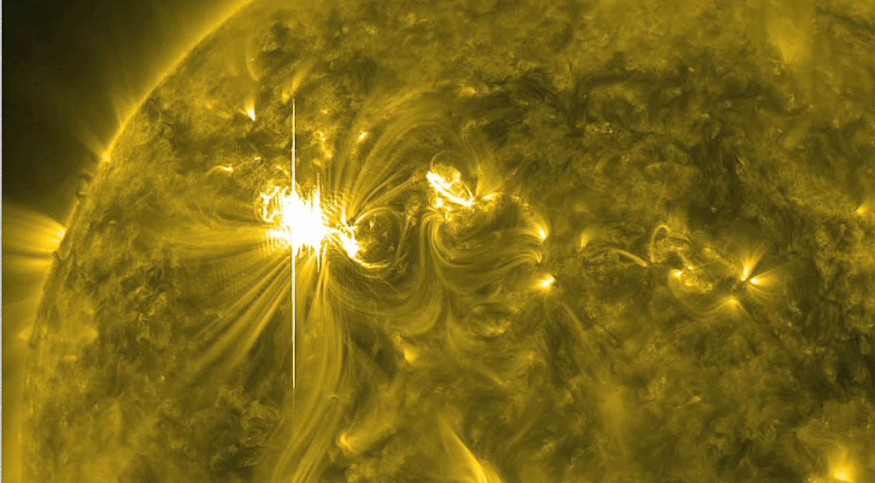The Space Weather Prediction Center (SWPC) of the National Oceanic and Atmospheric Administration (NOAA) has warned that a geomagnetic storm caused by a solar storm will impact Earth before the end of the month.
According to reports, the said storm is a warning that a space weather event might cause widespread communication and signal interruption.

In this handout from NASA/Solar Dynamics Observatory (SDO), a X5.4 solar flare, the largest in five years, erupts from the sun's surface March 6, 2012.
G1 Geomagnetic Storm To Hit Earth This March 2022
The storm came as a G1-class geomagnetic storm with a K-index of 5, according to the NOAA - SWPC. The solar storm conditions are likely to continue until later this month due to the combined effects from a coronal hole high speed stream (CH HSS) heading towards Earth along with a CME ejected from the Sun on Friday.
Its unsettled to active conditions are expected to last until Monday, March 28, as the CME effects persist. It will most likely return to its quiet condition on Tuesday, March 29.
This indicates that the planet's power systems may experience weak power grid oscillations. In addition, satellite operations, as well as spacecraft activities, may be affected.
Migratory animals could be harmed as well.
According to the US space weather service, the impact region is likely to be poleward of 60 degrees in Geomagnetic Latitude.
As a result, an aurora or northern lights might appear in the sky, which can be viewed in the upper United States, including Maine and Michigan.
The G1 level is the lowest of the five magnetic storm classifications.
About Solar Storms
A coronal mass ejection (CME) from a solar storm triggered the most recent space weather storm.
CMEs are caused by large-scale expulsions or disruptions in the magnetic field or plasma of the Sun's corona, according to NOAA-SWPC.
According to the National Aeronautics and Space Administration (NASA), a CME carries billions of tons of particles into space and travels millions of miles per hour.
These electrical particles have the potential to alter Earth's magnetic field.
Solar storms may also produce solar flares, which are brief bursts of high-energy radiation made composed of photons and particles ejected from the Sun's surface.
According to NASA, solar flares are the most powerful explosive phenomena in our solar system.
Risks That Solar Storm Poses To Planet
During a geomagnetic or solar storm, disturbances in the Earth's magnetic field can disrupt our electric and technical infrastructure, which is relied on radio waves from satellite communication.
These radio waves are used to deliver and receive information via signal-dependent electronics.
The United States Geological Survey (USGS) identified the following technical risks posed by geomagnetic storms across the world:
- Because storms may heat up and distort the ionosphere, which long-range radio communication relies on, the global positioning system (GPS) may become incorrect.
- Because of the ionosphere's growth, satellite orbital movement might be challenging.
- Increased radiation levels pose a serious threat to astronauts and high-altitude pilots.
- Static-electric charges can cause harm to satellite electronics.
- Power outages or even blackouts can result from voltage spikes.
When Do Solar Storms Happen
The Sun is a hot plasma-filled gaseous orb at the core of our solar system. It is the solitary star and primary source of energy in our star system, with an estimated age of 4.6 billion years.
Our Sun, on the other hand, is home to one of the universe's most intense space weather occurrences.
When the magnetic field of the Sun's corona, the outermost layer, becomes entangled and shifts back into place, solar storms occur.
According to Live Science, this process is known as "magnetic reconnection," and it allows CMEs and solar flares to be released.
A magnetic storm in 2003 knocked off electricity throughout the world, causing irreparable damage to power transformers and other electrical infrastructure.
Scientists worry that a powerful magnetic storm in the future will produce an "internet apocalypse," leaving us without internet for months.
RELATED ARTICLE : Solar Waves Now Move Three Times Faster Than Previously Thought
Check out more news and information on Space in Science Times.
© 2026 ScienceTimes.com All rights reserved. Do not reproduce without permission. The window to the world of Science Times.










